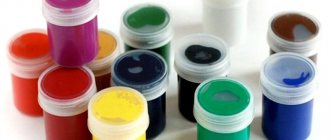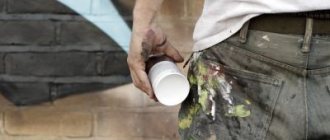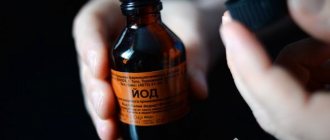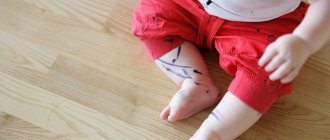Updated: 04/23/2021 12:22:04
Expert: Sofia Borisovna Fridman
A leaking pen, as well as an accidentally left mark from a fountain pen or stamp on clothing, can become a serious problem - removing ink stains is very difficult. But only if you don’t know how and with what to remove them. You can find many ways to remove this type of contamination in home economics books or on the Internet. But not all of them show good results. Our experts have tested each of the existing methods. We invite you to review the results of their testing to find out the most effective ways to remove ink stains.
Precautionary measures
It is very important to take precautions when removing the stain so as not to damage the fabric or harm yourself.
- The operation with the stain must be carried out using rubber gloves.
- Removing paint should only be done with the window open, in a ventilated area.
- If cleansing is done with chemicals (solvent, white spirit), it is advisable to wear a medical mask on your face.
- In some cases, the selected dye remover may not be suitable for the type of fabric, so it is necessary to test it first on a small area of the clothing, where a trace of the solvent will not be visible if a trace remains.
- When removing a stain (as you know, the procedure must be carried out from the inside out), a thick piece of fabric is placed on the front side.
Stories from our readers!
“My sister gave me this cleaning product when she found out that I was going to clean the barbecue and the wrought-iron gazebo at the dacha. I was delighted! I didn't expect such an effect. I ordered the same for myself.
At home I cleaned the oven, microwave, refrigerator, ceramic tiles. The product even allows you to get rid of wine stains on carpets and upholstered furniture. I recommend."
Washing rules
When attempting to remove ketchup stains from clothes, you must take into account the following rules for carrying out the work:
- You should not recklessly send a soiled item straight to the wash. This can lead to staining of everything in the drum of the machine and to the fact that traces of the sauce will become attached to the material.
- After the initial treatment, you need to start removing the trace left by spilled ketchup.
- Only after the stain has been properly processed and has disappeared from the material can you proceed to the main wash.
- After removing the stain, it is necessary to wash the item at the maximum permissible temperature. Additionally, a washing powder enhancer can be added.
- After washing, the item must be rinsed.
When using stain removers, store-bought or homemade, place a napkin or clean rag under the stained area. This is necessary in order to prevent the solution from leaking onto the clean, undamaged side of the item.
Things to consider
- If the item is expensive and you are afraid to take risks, it is better to immediately take it to the dry cleaner.
- If you want to clean the dirt yourself, don’t delay it. Try to scrub off the paint within the next few hours after the stain appears.
- If the paint has had time to dry thoroughly, first very carefully scrape off the top layer with a blade. This will make it easier to wash it off. But if the fabric is quite delicate, it is better not to use a blade, otherwise you may accidentally tear it.
- All the methods below are working. They have been tested by real people who have shared their experiences on various forums. But very often it is not clear what kind of paint left the mark. Therefore, if the product does not help, perhaps it is simply not suitable for the substance in which your item is stained.
- If the stain is large, you can try several products on it at once in different areas. This way you will know which method will definitely help you. If the stain is small and the chosen product cannot cope with it, just try another one, lightly rinsing off the previous one with water.
- Also test the selected product first on an inconspicuous area of clothing. This will ensure that the color of the fabric is not affected.
- You can rub the product into a rough cloth with any brush or the back of a dishwashing sponge. For delicate stains, it is better to rub it with your hands or clean the stain with the fabric itself, as when washing.
How to remove paint from clothes at home
At home, removing paint from clothes is even easier than taking it to the dry cleaner, because only you know how long the stain has been on the item and what type of paint it is. First, determine the type (composition) of the fabric so as not to spoil it with solvent. If this is not done, the fabric may not only change color, but also melt.
Action plan on how to remove the paint yourself:
- Use the blunt side of a knife to scrape any dried oil paint off the fabric before applying.
- Lubricate the stain with a greasy product (for example, vegetable oil).
- Test the effect of the selected stain remover on a piece of fabric (a place hidden from view in clothing). The acetate cloth will dissolve along with the stain if you use acetone.
- Rub the stain with a cotton swab soaked in one of the following:
- acetone nail polish remover;
- turpentine;
- refined gasoline;
- liquefied gas for lighters.
Wipe off any remaining greasy marks with ammonia.
There is another way to remove paint from clothes without harming the fabric:
- Take butter (preferably butter) and washing powder (1 tbsp each).
- Soften the butter and mix with the powder.
- Rub the mixture into the stain.
- Leave for a short time and wash.
Pre-soak the gouache stain to soak the paint. Wash with any special product.
Wipe the water-based emulsion stain with alcohol. If dirt remains, wash first in cold and then in hot water with the addition of detergent.
To remove acrylic paint, take vinegar and ammonia (2 tablespoons each), add salt (1 tablespoon). Apply the solution to the stain, wait 2 minutes and scrub with a brush. Rinse and evaluate the result.
Features of removing different types of paint and varnish products
To remove paint from jeans efficiently, you need to know what kind of composition they were stained with. The effectiveness of the chosen product depends on this.
Type of paint Which products are suitable Which products should not be used Oil-based White spirit, gasoline, kerosene, “butter + powder”, turpentine, vegetable oil. Washing powder will not be effective. Vinegar and lemon juice can cause the paint to set, making it impossible to remove. Acrylic Solvents containing acetone and alcohol, ammonia, glycerin. It is best to use liquid products. After drying, acrylic does not dissolve in water
Therefore, it will not be possible to wash it off. Ink Kefir, “ammonia + soda”, “hydrogen peroxide + ammonia”, turpentine. Vinegar must be used carefully so as not to fix the dye pigment in the fabric. Hair dye Kefir, soda, lemon juice, alcohol, hydrogen peroxide, glass washing liquid. Solvents and potent compounds may not be used. Most often it is possible to do without their help. Water-based Acetone, soap solution, alcohol, formic acid, gasoline, kerosene
Preference should be given to liquid solvents. It will not be possible to get rid of old paint using gentle means, for example, using lemon juice. Gouache, watercolor, stamp paint Washing powder, soap solution, dishwashing liquid, stain removers, glycerin. It is not recommended to use vinegar, lemon juice and other acids so as not to fix the pigment in the fabric.
How to remove stubborn paint from clothes
If soap can handle fresh stains, then more powerful products will help remove old paint from clothes. Always wear protective rubber gloves.
Enamel
Such fairly resistant paint as alkyd enamel will have to be removed using white spirit. Soak a cotton swab in solvent. Carefully work the stain, going 2-3 mm beyond its edges. If necessary, repeat the procedure until the contamination is completely removed.
Stamp
Stamp ink, which can be water-based, alcohol-based or oil-based, can be removed in several ways. Choose the appropriate one depending on the type of fabric. After any cleaning method, you need to wash the item of clothing in the washing machine in the appropriate mode.
- Ammonia plus turpentine. The ingredients must be mixed in equal proportions, applied to the surface of the fabric and wiped off with a rag after two hours. The method is suitable for delicate products.
- Denatured alcohol plus glycerin. This mixture is especially effective for removing paint stains from leather jackets. The proportion is 1:1. Using a soft cloth soaked in the product, carefully treat the stain, leave for 20-30 minutes and wash off.
- Mustard. In this simple way you can remove stamp ink stains from silk fabric. Mix mustard with water in such a proportion to obtain a thick paste. Apply it to the surface of the stain. After a day, rinse under the tap.
Facade
The most persistent stains on clothes are left by façade paint. It can be acrylic, silicate, cement, lime and siloxane. Such ingrained paint is quite difficult to remove from most fabrics. However, if you are sure that the item of clothing will “survive” boiling, you can try to remove the stains. At the very least, you can definitely remove acrylic paint stains from clothes by boiling them. Stains from stained glass paint are removed in a similar way. The procedure consists of ten steps.
- Wash your clothes in a basin in warm water using laundry soap.
- Fill a stainless steel bucket or pan with water halfway.
- Place on the fire to warm up.
- Add a tablespoon of soda ash.
- Place the clothes in a bucket of hot water and bring to a boil.
- Boil for no more than two to three minutes, then change the water and repeat the procedure.
- There is no need to add soda the second time, only one and a half tablespoons of powder.
- You can add an additional teaspoon of bleach if you need to remove dried dye from white clothes.
- After boiling, rinse the item of clothing in the washing machine and then wash at 40°C.
- After washing, put it on the rinse cycle again.
Carry out all manipulations with rubber gloves. Stir the clothes during the boiling process only with an unpainted wooden spoon or a dough roller. By boiling, stains from shedding can also be removed from clothing. Just instead of soda ash, add one tablespoon of white (if it is a light fabric) or just active washing powder.
Actions depending on the product used
So, how can you wash ink off your hands from a printer with inkjet cartridges? We stick to what we have at hand. Do not forget that all the liquids listed above are harmful to the body, and you should be extremely careful to avoid getting them into your eyes and mouth. In this case, we’ll start with Vanish Oxi Action detergent and then go down the list:
In the case of Vanish Oxi Action, we simply take a sponge, saturate it with the product and actively rub it on the contaminated surface of the skin, previously moistened with water. Dish sponges with a hard side are welcome. Then wash off the product under running water using laundry soap. If you don’t have anything else on hand other than hydrogen peroxide, that will do. True, you will have to rub more aggressively. For such cases, pumice is best suited. We moisten with peroxide, rub with pumice, rinse with water, moisten with peroxide again, rub, wash off, and so on until you are satisfied with the achieved result. How to wash printer ink off your hands, if not with paint thinner? You just need to use a solvent for oil paints, since printer paint has a similar base. Despite the fact that the components of the dye will dissolve in the solvent, the dye that has become embedded in the fabric will, again, have to be scrubbed off using pumice. Just as with peroxide, you may have to repeat the procedure several times
Bleach and products containing sodium hydrochloride should be used with extreme caution. Contact with such chemicals may cause an allergic reaction in some people.
Therefore, it is worth knowing about your body’s ability to resist such substances before coming into close contact with them. Getting such liquids into your eyes can even end in disaster. If you are confident in yourself and your body, pour a small amount of bleach (for example, “Whiteness”) onto the sponge and the contaminated area. Then thoroughly wash everything off with water and laundry soap two or three times.
Effective folk remedies for removing stains from clothes
Acrylic stains from non-natural fabrics are removed using proven folk remedies, including: alcohol-containing liquids, ammonia, vinegar and even tape. The reaction of fabric to a cleaning compound is unpredictable, which is why it makes sense to test it on an area of clothing that is not visible. If you have doubts about the effectiveness of the product, we recommend that you read the instructions on how to remove acrylic paint from clothes using folk remedies.
Scotch
The method has proven itself in removing dry stains from textured cotton fabric. You can try this method before washing them. Tape is glued to the straightened fabric, smoothed and carefully removed. Some of the dry paint remains on the adhesive tape. If necessary, repeat the procedure.
Stationery tape
Alcohol and alcohol-containing solutions
Acrylic is quite easily affected by alcohol, so the method is effective for all types of stains. Any light-colored alcohol-containing liquid is suitable for cleaning things: hairspray, glass cleaner, or alcohol itself. The sequence of work is as follows:
- Clothes are soaked in cold water for 15 minutes.
- It is laid out on oilcloth (it is not necessary to wring it hard before doing this).
- The paint stain is moistened with an alcohol-containing solution.
- The area of contamination is wiped (movements go from the periphery to the center).
- The composition is reapplied and left to absorb for an hour.
- At the final stage, you need to scrub the stain with a sponge or clothes brush and wash.
Ethanol
Isopropanol
Isopropyl alcohol is widely used in medicine as an antiseptic, so it can be purchased at the pharmacy. Step-by-step instructions on how to remove acrylic paint from clothes with isopropyl alcohol:
- Prepare your work surface by covering it with film.
- Wet the stain generously with alcohol. It should saturate the stain well.
- Using a sharp object, carefully scrub the paint from the edges to the center of the stain. At this stage you should try to remove as much paint as possible.
- Rinse the item in cold water.
- Wash in the washing machine to remove any remaining alcohol and paint.
- If necessary, if the item is not washed, repeat the entire sequence of actions again.
Isopropanol
Ammonia mixture
Some people advise trying to wash acrylic with vinegar or ammonia. It is most effective to prepare a mixture of them with the addition of a pinch of table salt. Vinegar and ammonia are taken in a 1:1 ratio. Followed by:
Soak the damaged item in water for 15 minutes. Wring out, spread on film. Apply the mixture prepared in advance with a cotton pad to the stain. Gently rub the dirt; the paint should come off. Rinse clothes. To remove any remaining dirt, wash the item as usual.
A mixture of ammonia and vinegar
The subtleties of removing old ink from jeans
When removing old ink blots from denim, you need to take into account some nuances:
- before starting work, you must do a test on the fabric;
- while working, you should wear rubber gloves and do not neglect safety rules;
- It is better to place a flat board made of cardboard or plastic, wrapped in a white cloth, under the stain to be treated to avoid the transfer of paint from the fabric to the product and the flow of the chemical to the other side of the item;
- You shouldn’t start the fight against ink stains with the strongest chemicals; it’s better to try weak solutions and gentle agents first;
- It is convenient to apply the chemical to a small spot with a pipette;
- processing should be done from the edge of the stain to its center to avoid smearing the ink beyond the contamination;
- after removing the ink using any method, the jeans should be washed;
- if necessary, treatment is carried out several times;
- Jeans should not be washed with other clothes without first removing the stain.
The above tips and rules will help you deal with any ink stain, and your jeans will last for a long time.
Source of the article: https://domibit.ru/byt/stirka/kak-otstirat-chernila-s-dzhinsov/
How to remove printer ink from clothes |, How to remove printer ink from jeans.
How to clean fabric from felt-tip pen marks
To achieve results, when choosing a cleansing product, you need to take into account the type of ink pencil and the composition of your clothing.
When drying, the pigment is absorbed into the fibers of the material. An old felt-tip pen stain cannot be removed. To remove dirt, you need to remove the stained area within 5 minutes.
Shirts, T-shirts, jeans and other wardrobe items can be soaked in cold water using special chemicals. Powders are used to clean furniture and upholstery materials.
There are chemical compounds that can remove stains. You can wash clothes using improvised means:
- A high-quality solvent or nail polish remover is suitable for jeans. After treatment, the product must be rinsed in soapy water to eliminate the unpleasant odor.
- Cotton is washed with a solution of hydrogen peroxide.
- The marker is removed from the wool with lemon juice. To clean marker stains from black clothes, you need to take into account that the product corrodes the coloring pigment.
- Alcohol is suitable for carpets.
- Hairspray applied to a cotton pad will remove dirt from your sofa upholstery.
White
To wash felt-tip pen from white clothes, you need to determine the type of material.
| Fabric type | Means | Mode of application |
| Cotton products | Food grade vinegar | Vinegar is diluted with water in a ratio of 1:2. Soak the product in the mixture for 2-3 hours, periodically you need to wipe off the dirt with a clean napkin. Rinse the item in the machine, choosing the optimal mode. To wash the felt-tip pen, it is recommended to use a food product. Suitable for ingrained traces of dirt in the fibers of clothing, whitens the material. Acetic acid corrodes the skin of your hands. Rubber gloves are used for protection. |
| Synthetic fabric | Table salt solution | For one liter of water take five tablespoons of table salt. Soak clothes for 3-4 hours. To wash off the remnants of a felt-tip pen, use an automatic machine, choosing the appropriate powder. Solvents and products containing solvents are not used for synthetics. The components destroy the fibers. |
| Silk products | Turpentine | You need to apply the liquid to a cotton pad and treat the marker stain. To remove marks from clothes and eliminate unpleasant odors, use aromatic gels. |
| Atlas | Lemon juice combined with milk | To make the solution, the ingredients are taken in a 1:2 ratio. The resulting mixture is distributed onto the stain. Leave for 1-2 hours. The item should be rinsed in cold soapy water. |
| Wool material | Toothpaste | The substance is applied to the dirt from the felt-tip pen and carefully cleaned with a soft bristle brush. The paste absorbs dirt. The used product is removed and a new layer is applied. To remove the pigment, the procedure is repeated until the traces completely disappear. Clothes should be rinsed in cool water using special detergents for cleaning woolen items. |
Colored
Before washing clothes, you need to check the durability of the pattern. The selected product is applied to a small area.
To remove dirt from colored and dark items without damaging the fiber structure, do not use bleach or bleach. The components destroy the pigment.
To remove marker stains from colored clothes, they resort to different cleaning methods.
The coloring pencil is removed from products with laundry soap. Algorithm of actions:
- grate the block;
- dissolve the soap with water to a paste consistency;
- apply the mixture to the stain, leave for 1-2 hours;
- To wash clothes from felt-tip pen residues, use a machine.
Stain removers:
- Medical alcohol. The substance must be applied with a cotton swab to the stained area.
- The mark should be rubbed with tar soap and left for 10-15 minutes. To remove marker residue, use gel or liquid soap.
- A mixture of technical alcohol and glycerin. The components are mixed in a ratio of 2:1. The solution is applied to the contamination. After 30-40 minutes, the clothes are washed and sent to the washing machine.
- Stain removers for colored fabrics.
Features of printer ink stains
You need to deal with ink stains without delay. The fresher the paint, the easier it is to remove. If you deal with the dirt right away, you can wash it off without resorting to complex manipulations.
The toner quickly eats into the fibers and spreads across the fabric, covering a large area. Therefore, it is important not to give him such an opportunity. To limit the area of contamination, you can sprinkle it with talcum powder, crushed chalk or starch.
After cleaning, stains often remain, so for maximum cleanliness, it is necessary to wash the item completely.
Dried stains and stains after the first cleaning can be removed with fairly aggressive products. Even household chemicals can’t always remove long-standing ink marks, so don’t delay washing.
When choosing a toner remover, you should always check how the fabric behaves. Especially if a colored item or clothing made of delicate material has been damaged. Therefore, first the selected drug is tested on an inconspicuous part of the product, for example, on the inside of the seam. If after 10-15 minutes nothing bad has happened to the fabric, you can safely begin removing stains.
Prevention is the key to healthy and clean skin
When printer ink gets on your skin, it's not just dirt, it's also an active chemical. The first problem is to remember this in time and carefully protect your face, especially your eyes, from the touch of your hands.
Then the problems multiply. The paint is designed to soak into the paper. Naturally, the pores of the skin are perceived as an excellent surface for carrying out the mission, and it is very difficult to remove paint from your hands without active agents.
However, everything is not so bad. Water-based ink can be washed off with plain water (although not always and not completely), but inkjet printers use oil bases that cannot be washed off without the use of aggressive chemicals.
What to do to avoid such a difficult situation? Elementary. You just need to use thin rubber gloves, which will help you work comfortably and still have absolutely clean hands.
Oil paint
It is advisable to remove oil paint from the textile covering of furniture, carpet or clothing before its drops dry. Even in a fresh state, contamination is difficult to remove, and after drying, special techniques will be required.
Several proven options:
The contaminated area of the T-shirt or shirt is moistened and treated generously with laundry soap until a stable foam appears. After 10 minutes, wipe off all traces with a brush. More complex dried marks from dense fabric are removed with a solvent for oil varieties. Oil—butter, vegetable, or rendered pork fat—helps clean a thin knitted sweater or silk dress. Using the blunt side of a knife, remove the top film and rub the oily product from the inside. After 30 minutes the item is washed. You can combine equal volumes of butter, softened at room conditions, with two types of powder - laundry detergent to remove stains. Rub this mass into the colorful print for 15 minutes. If a leather jacket requires cleaning, use glycerin. It is slightly heated using a water bath and a cotton swab is soaked
Carefully rub off all marks.
Stains of oil paint that have fallen on the rug can be removed by a mixture of white clay and refined gasoline. Stir until the consistency of sour cream. Placed on prints. After 20 minutes, scrub them with a hard metal sponge or brush.
Basic rules for removing paint from pants
These rules include:
- If the paint has dried, you will have to try hard to remove it successfully. It’s easier to wipe off fresh dirt, so don’t hesitate.
- Before processing, the pants should be turned inside out, and a napkin should be applied to the stained area on the front side so that the paint can be absorbed into it.
- Cleaning the surface of a stain always begins from its edges and continues towards the center.
- Dense material is easier to clean. Thin, light fabric will require a lot of effort.
- It is recommended that you first try the action of solvent and gasoline on a similar material to make sure they are safe for this type of fabric.
- If too large an area is dirty, it is better to immediately contact a dry cleaner. Don't waste time trying to deal with a large stain at home.
Removing paint stains from thick denim fabric is not difficult.
Tips for light denim lovers
How can you remove paint from jeans if they are made of light-colored fabric? One of the most effective and safest remedies in this case is white cosmetic clay. Combine 20 g of clay and crushed chalk. Add the same amount of Galoshes. Leave the mixture on the damp, contaminated area for 20 minutes. Use a stiff sponge to remove any residue, rinse thoroughly under the tap and wash your white jeans with bleach.
And one more cleaning tip: if you couldn’t get rid of the stain in one go, glycerin will help remove the dye from your jeans. Treat the fabric with it and leave for 10-12 hours. Clean off any softened residue and machine wash your jeans.
The easiest way to remove fresh and slightly dried paint stains from jeans. But even if the problem is discovered after a week, the item can be saved. Depending on the type of paint, different methods of removing it are used.











